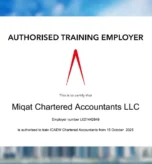Understanding the Impact of the UAE’s Domestic Minimum Top-Up Tax (DMTT) on Multinational Enterprises
Introduction: Advent of the Domestic Minimum Top-Up Tax (DMTT) in the UAE

The United Arab Emirates has implemented the Domestic Minimum Top-Up Tax (DMTT), effective for financial years starting on or after 1 January 2025. This measure is a significant shift for the UAE—a country historically known for its low-tax environment and business-friendly incentives.
The DMTT is part of the UAE’s commitment to align with the OECD’s Pillar Two global minimum tax framework, ensuring that large multinational enterprises (MNEs) with consolidated revenues of at least €750 million pay an effective tax rate of 15% in the UAE, similar to other GCC nations.
Purpose and Objective
- International Alignment: The UAE introduced the DMTT to meet the global standards set out in the OECD/G20’s Base Erosion and Profit Shifting (BEPS) project.
- Protection of Tax Base: By enforcing a top-up to the 15% minimum rate, the UAE ensures additional taxes on local profits accrue to its own treasury rather than to foreign jurisdictions.
- Maintaining Competitiveness: The regime balances global compliance with the UAE’s reputation for business friendliness, providing reliefs and incentives to support genuine economic activity.
Scope: Who Is Subject to the DMTT?
- In-Scope Groups: MNEs with annual consolidated revenues of at least €750 million (approx. USD 828 million/AED 3 billion) in at least two of the last four fiscal years—including both UAE-based MNEs and foreign-headquartered MNEs with UAE operations.
- Included Entities: All UAE constituent entities and eligible joint ventures in these MNE groups.
- Excluded Entities: Governmental entities, sovereign wealth funds (meeting set criteria), pension funds, non-profit organizations, certain investment and real estate vehicles, and international organizations.
Note: Smaller UAE businesses and entities with no cross-border activity are not affected.
General Provisions for DMTT Application
- Jurisdictional Basis: Applies to the combined results of all in-scope UAE entities.
- Minimum Effective Tax Rate (ETR): If below 15%, a top-up tax is imposed.
- Integration with UAE Corporate Tax: DMTT complements the 9% corporate tax.
- OECD Model Alignment: Follows OECD’s Pillar Two GloBE Model Rules, with UAE-specific adjustments.
Calculation of the DMTT
- Calculate Pillar Two Income and Taxes: Based on IFRS or equivalent.
- Determine ETR: Total adjusted taxes ÷ net Pillar Two income.
- Apply Top-Up: If ETR < 15%, the difference is applied to excess profits after exclusions.
Example: A UAE subsidiary with €200M in profit and €18M in tax owes €12M as DMTT.
Substance-Based Income Exclusion: Payroll and tangible assets receive partial relief.
Additional Current Top-up Tax: Required for restatements or permanent differences.
To Whom Does the DMTT Apply?
- MNE Groups: With local and/or cross-border UAE subsidiaries.
- Joint Ventures & Minority-Owned Entities: Based on equity and consolidation rules.
- Free Zone Entities: In-scope Free Zone MNEs are still liable despite 0% CT.
- Investment Entities & SWFs: Often excluded, but portfolio entities may still qualify.
Legal & Reference Sources:
- Cabinet Decision No. 142 of 2024
- Federal Decree-Law No. 60 of 2023
- UAE Ministry of Finance, PwC, and Virtuzone resources
- CDA Audit example, Virtuzone, and OECD framework
Impact of DMTT on MNEs in the UAE
- Increased Tax Burden: Especially for groups benefiting from 0%/low CT.
- Complex Compliance: New data collection and GloBE-specific systems required.
- Strategic Shift: Transfer pricing and profit allocation may need restructuring.
- Joint and Several Liability: All UAE entities may share responsibility.
- International Competitiveness: DMTT preserves the UAE’s global tax credibility.
DMTT Filing and Compliance Requirements
- Registration: All in-scope UAE entities must register with the FTA.
- Filing the Return: Due 15 months post-fiscal year end (18 months for first year).
- CbCR: Qualified Country-by-Country Reporting is needed for safe harbours.
- Document-Keeping: Retain records supporting filings for 7 years.
- Penalties: For non-compliance, as per UAE CT Law.
- Clarifications: Can be requested via the Emaratax portal.
Reliefs and Safe Harbours Under UAE DMTT
- Permanent De Minimis Safe Harbour: No DMTT if avg. UAE revenue < €10M and profits < €1M over 3 years.
- Transitional CbCR Safe Harbour: Valid until 2028 for simplified tests + qualified CbCR.
- Initial International Activity Exclusion: For new MNEs with limited jurisdictions/assets abroad.
- Permanent Simplified Computation: For groups meeting simplified ETR thresholds.
- Transitional Substance Relief: Higher carve-outs until 2032 for payroll/assets.
- Shipping Companies: Special exemptions and simplified rules apply.
Steps for MNEs to Ensure DMTT Compliance
- Assess Scope
- Conduct Impact Assessment
- Upgrade Reporting Systems
- Register and Plan
- Update Transfer Pricing Policies
- Prepare Financial Statements with Pillar Two Disclosures
- Monitor Relief Options
- Engage Professional Support
The Broader Strategic Impact
- Market Position: DMTT slightly reduces the UAE tax advantage but maintains appeal due to regulatory clarity and infrastructure.
- Global Tax Reputation: Strengthens UAE’s credibility as a compliant tax jurisdiction.
How Can Miqat Help with DMTT Tax Filing?
- Impact assessments and readiness reviews
- Group registration, CbCR upgrades, coordinated filings
- Support with financial system changes and data gathering
- Advisory on intra-group restructuring and risk management
- Ongoing regulatory updates and post-implementation reviews
In Summary
The DMTT represents a pivotal evolution for UAE tax policy, setting a new minimum for large multinationals while empowering the UAE to keep tax revenue local and ensure ongoing compliance with international standards.
For MNEs, this brings new complexity, but also greater certainty and global alignment—provided they act early, stay compliant, and make use of transitional reliefs and professional guidance.





